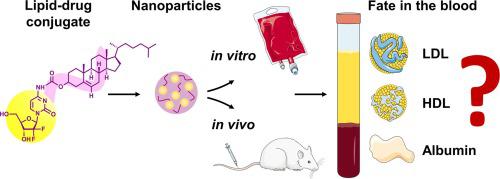International Journal of Pharmaceutics ( IF 5.3 ) Pub Date : 2021-09-02 , DOI: 10.1016/j.ijpharm.2021.121076 Eleonore Coppens 1 , Didier Desmaële 1 , Timothée Naret 2 , Sébastien Garcia-Argote 2 , Sophie Feuillastre 2 , Grégory Pieters 2 , Catherine Cailleau 1 , Jean-Louis Paul 3 , Bastien Prost 4 , Audrey Solgadi 4 , Jean-Philippe Michel 1 , Magali Noiray 1 , Patrick Couvreur 1 , Simona Mura 1

|
A simple approach to achieve a lipoprotein (LP)–mediated drug delivery is to trigger the spontaneous drug insertion into endogenous lipoproteins in the bloodstream, by means of its chemical modification. Nanoparticles (NPs) made of the squalene–gemcitabine (SQGem) conjugate were found to have a high affinity for plasma lipoproteins while free gemcitabine did not, suggesting a key role of the lipid moiety in this event. Whether the drug conjugation to cholesterol, one of the major lipoprotein-transported lipids, could also promote an analogous interaction was a matter of question. NPs made of the cholesterol–gemcitabine conjugate (CholGem) have been herein thoroughly investigated for their blood distribution profile both in vitro and in vivo. Unexpectedly, contrarily to SQGem, no trace of the CholGem prodrug could be found in the lipoprotein fractions, nor was it interacting with albumin. The investigation of isolated NPs and NPs/LPs physical mixtures provided a further insight into the lack of interaction of CholGem NPs with LPs. Although essential for allowing the self–assembly of the prodrug into nanoparticles, the lipid moiety may not be sufficient to elicit interaction of the conjugated drug with plasma lipoproteins but the whole NP physicochemical features must be carefully considered.
中文翻译:

吉西他滨脂质前药纳米颗粒:转换脂质部分并改变血流中的命运
实现脂蛋白(LP)介导的药物递送的一个简单方法是通过其化学修饰触发药物自发插入到血液中的内源性脂蛋白中。研究发现,由角鲨烯-吉西他滨 (SQGem) 缀合物制成的纳米颗粒 (NP) 对血浆脂蛋白具有高亲和力,而游离吉西他滨则不然,这表明脂质部分在此事件中发挥着关键作用。药物与胆固醇(主要脂蛋白转运脂质之一)的结合是否也能促进类似的相互作用是一个问题。本文对由胆固醇-吉西他滨缀合物 (CholGem) 制成的纳米颗粒的体外和体内血液分布情况进行了彻底研究。出乎意料的是,与 SQGem 相反,在脂蛋白级分中没有发现 CholGem 前药的痕迹,也没有与白蛋白相互作用。对分离的 NP 和 NP/LP 物理混合物的研究进一步深入了解了 CholGem NP 与 LP 相互作用的缺乏。尽管脂质部分对于将前药自组装成纳米颗粒至关重要,但可能不足以引发缀合药物与血浆脂蛋白的相互作用,但必须仔细考虑整个纳米颗粒的物理化学特征。










































 京公网安备 11010802027423号
京公网安备 11010802027423号